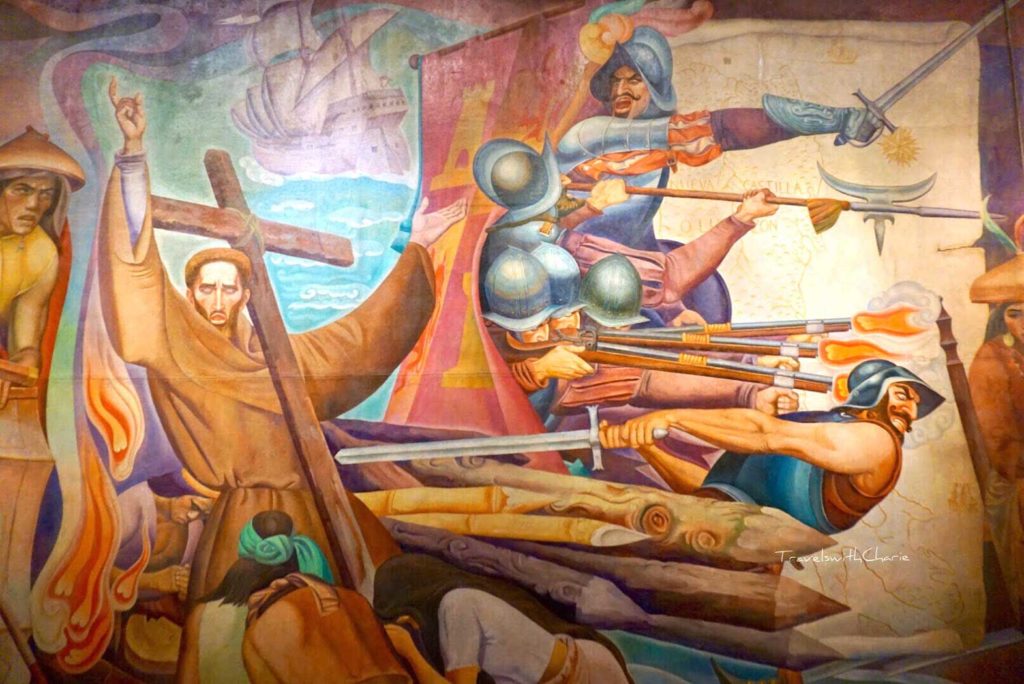
Filipino Struggles in History, by Carlos “Botong” Francisco
NEW YORK—Last month, writing to Mexican bishops, Pope Francis urged the local clerical hierarchy to reconsider the role of the Roman Catholic Church in the Spanish conquest and colonialization of that country. In his view, it was necessary to “recognize the painful errors committed in the past.”
Unsurprisingly, the papal commentary proved to be controversial, not in Mexico, but with the right wing in Spain. The prominent Madrid conservative Isabel Díaz Ayuso professed to be surprised by the fact that “a Catholic who speaks Spanish would talk that way,” as though all Spanish speakers had necessarily the same benign interpretation of Spanish empire. Ayuso further declared that Imperial Spain through its conquistadors had five centuries ago bestowed on the Americas “civilization and freedom.”
The Spanish right wing’s reaction is an echo of the conservative white backlash in the United States, against the inclusion in school curricula of critical race theory, on the basis that such an emphasis on a more complex and nuanced representation of the past has made and would continue to make white students ashamed of themselves. And like their US counterparts, the Spanish right wingers are exploiting the issue for political reasons, e.g., rendering them more prominent in the public eye, and disturbingly, give white supremacists cover for their hateful platforms.
The sword and the cross symbolized perfectly Spanish expansion and colonial rule. One or the other led, a kind of Tweedledum-Tweedledee relationship. In Las Islas Filipinas this resulted in what the late Jesuit historian Horacio de la Costa called a missionary state. Wielders of the sword and proselytizers of the Church didn’t always get along; for the most part, the friars had the upper hand. Not only were they more numerous, they were in the colony for the long haul, whereas the civil servants for the most part had term limits.
Ayuso and her ilk no doubt would hold the same view regarding the Spanish in the Philippines. Did in fact the Spanish occupation of the archipelago bring about civilization for the various indigenous peoples? It’s a problematic question, foregrounded by the assumption that prior to the arrival of the Spanish, what existed was a tabula rasa, or an empty slate on which the colonizers could inscribe and prescribe their ways of thinking, seeing, and acting in the world, with of course, themselves in the center. The Southeast Asian colony may have represented a new world, but what the Spanish expatriate wanted was to re-create as much as possible the culture specific to his time and place back in the Iberian peninsula.
If that meant displacing and even demolishing age-old practices, so be it. The thought of “going native” was anathema. Native practices and rituals were dismissed as superstitions. For the good of the islanders, the Spanish would remake the new world in their image, a white patriarchy in lieu of a matriarchy—a Christ looking very much like a fair-skinned Spanish grandee—, with all the attendant regressive perspectives when it came to the role of women in society.
These perspectives are contrasted masterfully in Nick Joaquin’s short story, “The Summer Solstice,” set in 1850. Two feasts are celebrated during the longest day of the year: that of St John the Baptist, and the festival of the Tadtarin, a frenzied, women-only, Mardi-Gras type ritual asserting women’s primacy—and a not-too-subtle rebuke, if not outright repudiation, of the repressive hierarchs of a male god. The rites of the Tadtarin hark back to pre-Hispanic times, when the spiritual guides and healers in the archipelago were women, called the babaylan in the Visayas, and katalonan in the Tagalog regions. Some babaylan/katalonan were feminized men.
Joaquin deftly contrasts the two celebrations, the first one at noon: … St John riding swiftly above the sea of dark heads and glittering in the noon sun—a fine, blonde heroic St John: very male, very arrogant: the Lord of Summer, indeed; the Lord of Light and Heat—erect and goldly virile above the prone and female earth …
And the other in the early evening: Behind her, a group of girls bore aloft a little black image of the Baptist—a crude, primitive, grotesque image, its big-eyed head too big for its puny naked torso, bobbing and swaying above the hysterical female horde …The tensions between the two traditions are embodied in the relationship between the handsome upper-class young couple, Don Paeng and Doña Lupe. Lupe, ordinarily the model of wifely submission, becomes entranced by the liberating spirit the Tadtarin offers: a chance to reverse the couple’s roles. The story ends brilliantly, with Lupe transformed into a powerful and assertive female, demanding—and getting—worshipful tribute from her spouse, crawling to lie at her feet: She raised her skirts and contemptuously thrust out a naked foot. He lifted his dripping face and touched his bruised lips to her toes, lifted his hands and grasped the white foot and kissed it savagely—kissed the step, the sole, the frail ankle—while she bit her lips and clutched in pain at the windowsill, her body distended and wracked by horrible shivers, her head flung back and her loose hair streaming out the window—streaming fluid and black in the white night where the huge moon glowed like the sun and the dry air flamed into lightning and the pure heat burned with the intense fever of noon.
Far more powerful than academic exegeses, “The Summer Solstice” shows the cost of bringing in a particular kind of civilization: the resulting denigration and displacement of what was already hallowed and ingrained in the native self. Theirs was the type that actively excluded other civilizations—and we have been paying the price ever since.
Copyright L.H. Francia 2021

